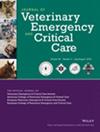2024 RECOVER Guidelines: Advanced Life Support. Evidence and knowledge gap analysis with treatment recommendations for small animal CPR
Abstract
Objective
To systematically review the evidence and devise clinical recommendations on advanced life support (ALS) in dogs and cats and to identify critical knowledge gaps.
Design
Standardized, systematic evaluation of literature pertinent to ALS following Grading of Recommendations, Assessment, Development, and Evaluation (GRADE) methodology. Prioritized questions were each reviewed by Evidence Evaluators, and findings were reconciled by ALS Domain Chairs and Reassessment Campaign on Veterinary Resuscitation (RECOVER) Co-Chairs to arrive at treatment recommendations commensurate to quality of evidence, risk:benefit relationship, and clinical feasibility. This process was implemented using an Evidence Profile Worksheet for each question that included an introduction, consensus on science, treatment recommendations, justification for these recommendations, and important knowledge gaps. A draft of these worksheets was distributed to veterinary professionals for comment for 4 weeks prior to finalization.
Setting
Transdisciplinary, international collaboration in university, specialty, and emergency practice.
Results
Seventeen questions pertaining to vascular access, vasopressors in shockable and nonshockable rhythms, anticholinergics, defibrillation, antiarrhythmics, and adjunct drug therapy as well as open-chest CPR were reviewed. Of the 33 treatment recommendations formulated, 6 recommendations addressed the management of patients with nonshockable arrest rhythms, 10 addressed shockable rhythms, and 6 provided guidance on open-chest CPR. We recommend against high-dose epinephrine even after prolonged CPR and suggest that atropine, when indicated, is used only once. In animals with a shockable rhythm in which initial defibrillation was unsuccessful, we recommend doubling the defibrillator dose once and suggest vasopressin (or epinephrine if vasopressin is not available), esmolol, lidocaine in dogs, and/or amiodarone in cats.
Conclusions
These updated RECOVER ALS guidelines clarify the approach to refractory shockable rhythms and prolonged CPR. Very low quality of evidence due to absence of clinical data in dogs and cats continues to compromise the certainty with which recommendations can be made.

 求助内容:
求助内容: 应助结果提醒方式:
应助结果提醒方式:


